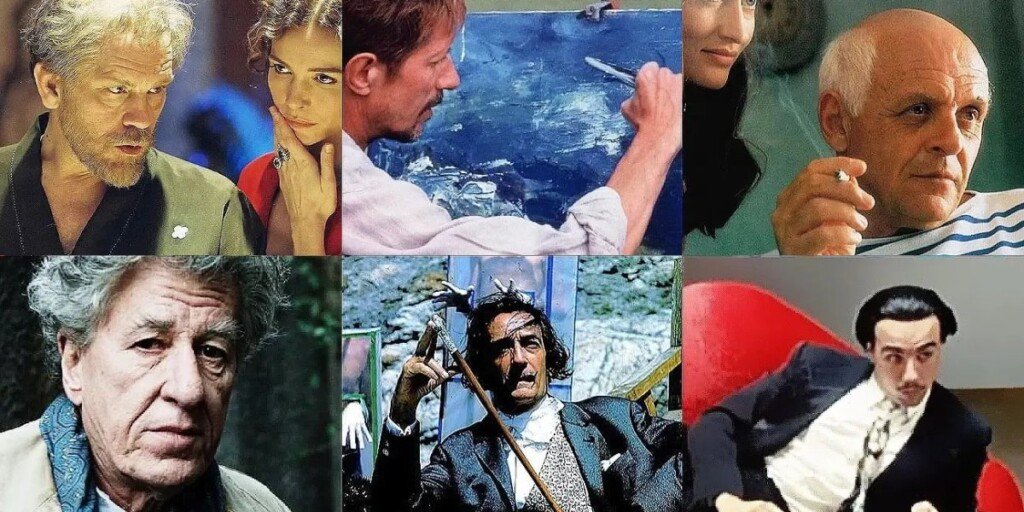I’m not an art expert. I don’t have a formal background in cinema, either. I’ve always been drawn to that strange, magnetic space where creativity begins. It is the quiet moment before the brush hits the canvas. It is also before the camera starts rolling. Lately, I have been looking for films that go beyond telling me about the great artists. They help me feel what it has been like to live inside their chaos. They let me experience their doubt and their genius.
What I found were six very different films — some poetic, some raw, some downright strange. But all of them made me pause. And think. And, in some cases, feel oddly understood.
This isn’t a ranked list or a critic’s guide. It’s just a personal collection. It comes from someone who’s still trying to make sense of what art really is.
This isn’t really about Picasso the painter — it’s about Picasso the partner, the manipulator, the myth. The film is told through the eyes of Françoise Gilot. She was the only woman who managed to leave him with her soul intact. The film doesn’t shy away from the emotional wreckage genius can cause.
Watching Gilot hold onto her own artistic vision while being pulled into Picasso’s orbit was more than just inspiring. It was a quiet form of defiance. She paints. She survives. And in the end, she walks away. That, to me, was one of the most powerful portrayals of creative strength I’ve seen in a film.
Want to know more about Picasso’s complex relationships and how they influenced his art? Discover the biography Picasso: Creator and Destroyer by Arianna Stassinopoulos Huffington. It inspired the film. The book provides a rich look at the man behind the myth. Read more about Picasso’s life and works.
This film doesn’t explain Klimt. It embodies him. It’s disjointed, decadent, and unapologetically strange — just like the artist himself. The plot wanders through memories, dreams, and hallucinations as if the entire film is one of Klimt’s golden canvases come to life.
I found myself occasionally lost, but also mesmerized. Klimt’s obsession with beauty, women, and the sensory world isn’t just told — it’s felt. If you’re okay with a movie that values mood and atmosphere over traditional storytelling, this one lingers.
Curious about Klimt’s art and its symbolism? Check out the detailed analysis on The Art Story, which explores Klimt’s Golden Phase and how his works shaped the Art Nouveau movement. Discover Gustav Klimt’s life and masterpieces.
I expected drama, torment, and theatrical brushstrokes. Instead, I got something far more intimate: Vincent Van Gogh as a man. This film captures the last two months of his life in quiet moments. It shows detailed scenes of him painting, talking, and walking. He is slipping slowly into despair.
What moved me most was the ordinariness of it all. No exaggerated legends. Just a human being trying to make sense of the world with paint. The result is hauntingly honest. This is not the Van Gogh of museum postcards. This is the Van Gogh who existed between the masterpieces.
Want to explore the real Van Gogh behind the myths? The Van Gogh Museum’s official website offers a treasure trove of letters, artwork, and insights into his life and legacy. Explore Vincent Van Gogh’s letters and art.
Dalí (1991)
Director: Antoni Ribas
Writers: Enric Gomà, Temístocles López, Antoni Ribas
Stars: Lorenzo Quinn, Sarah Douglas, Michael Catlin
Runtime: 116 min
IMDB
Dalí was always his own greatest creation, and this film tries to keep up with that energy. It’s about more than just the man’s art. It’s about his persona and his obsession with Gala. His flirtation with the absurd is also highlighted. Additionally, there is his constant need to turn life into performance.
The film is not as emotionally deep as it has been. Yet, it still captures Dalí’s essence. It reveals his brilliance and his self-obsession. I watched it more as a collage of eccentric moments than a coherent biography. Somehow, that felt right.
If you want to peek deeper into Dalí’s surreal world, visit the Salvador Dalí Museum’s website. It provides stunning galleries and insights into his techniques and life. Dive into Salvador Dalí’s surreal art.
Salvador Dalí: A Soft Self-Portrait (1970)
Director: Jean-Christophe Averty
Narrator: Orson Welles
Runtime: 52 min
IMDB
This short documentary is a surrealist time capsule. Shot in Dalí’s seaside home, narrated by Orson Welles, it’s less a documentary than a poetic meeting. There’s no effort to pin Dalí down. Instead, the film lets him act, play, confuse, and enchant.
It’s strange, yes. But also strangely personal. For a few moments, it’s like being invited into the weird, wonderful world of Dalí, without needing to understand everything.
Want to experience the surreal in Dalí’s own words and visuals? This documentary offers a rare glimpse into his world. Open Culture provides a thoughtful article and viewing links for those curious. Watch and learn more about A Soft Self-Portrait of Salvador Dalí.
This is the only film on the list that focuses almost entirely on making one piece of art. It shows how impossible that can be. It’s based on the true story of writer James Lord. He sits for a portrait by Giacometti. The process spirals far beyond its original plan.
I loved how small and slow this film was. Giacometti is brilliant, erratic, self-loathing, and deeply human. Watching him destroy and restart the portrait again and again felt painfully familiar. It was as if the closer we get to something true, the more afraid we are to finish it.
Interested in the complex life and artistry of Alberto Giacometti? James Lord’s memoir A Giacometti Portrait offers a beautifully written account. It provides an intimate look at the man. It also explores the making of this famous portrait. Discover more about Alberto Giacometti.
For Anyone Who’s Ever Tried to Create Something
Art isn’t always about the finished masterpiece hanging in a museum or the genius label we attach in hindsight. Sometimes it’s about the unfinished portrait, the erased lines, the maddening repetition, or the decision to walk away.
These films reminded me that creation is rarely neat or glamorous. It’s deeply human. It’s full of fear, obsession, failure, stubbornness — and the occasional flash of something true.
If you’ve ever tried to create something from nothing, you relate to these stories. This can be a sketch, a sentence, or even a life.
Written by Discoverer of ART
Editor, curator, publisher
Twitter (X) – @DesignResource_





